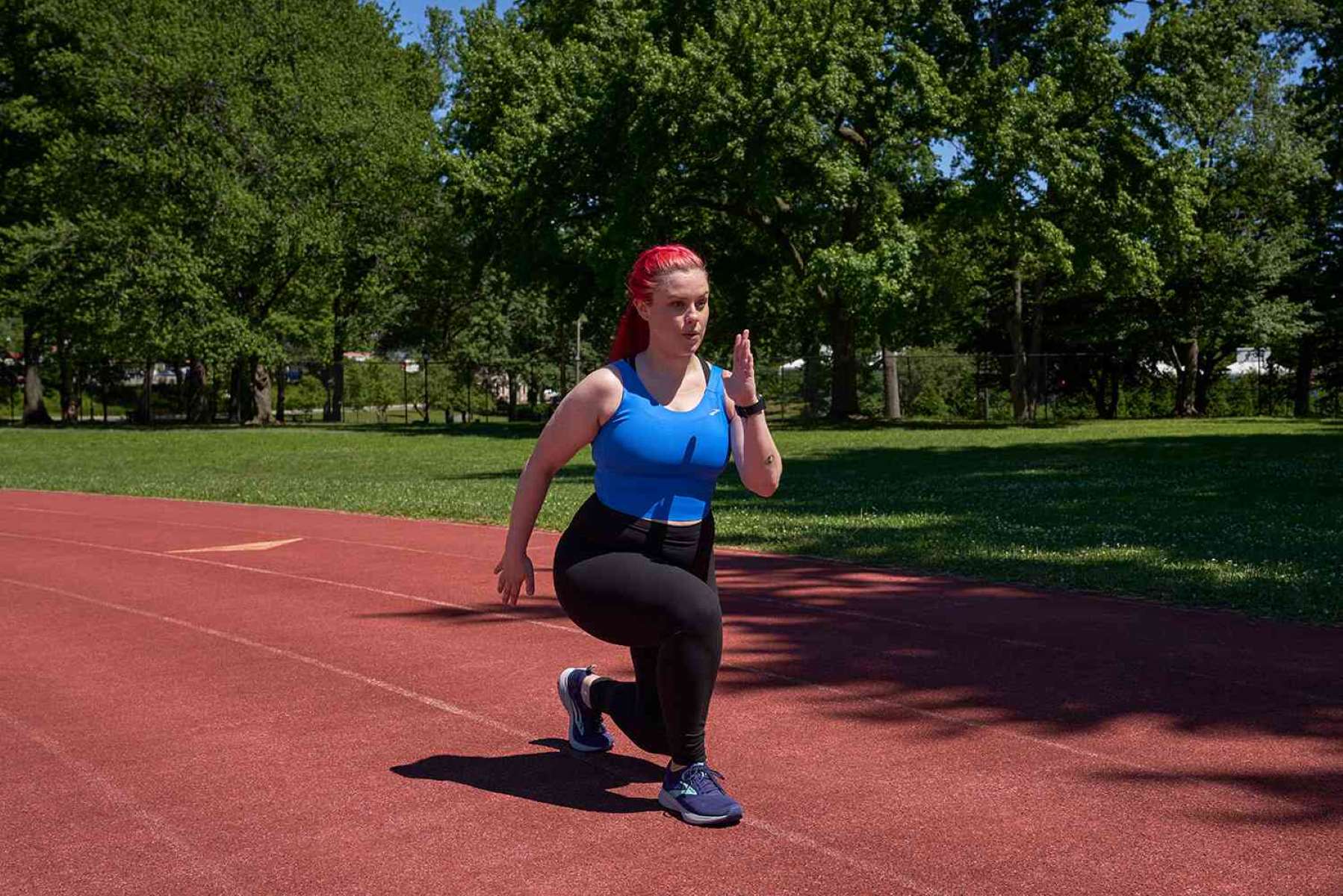

Featured
How To Build Up Endurance Fast
Modified: January 22, 2024
Discover the secrets to building endurance fast with our featured guide. Learn proven strategies and techniques to enhance your stamina and reach your fitness goals.
Introduction
Building up endurance is a crucial aspect of any fitness journey, whether you’re training for a marathon, improving your cardiovascular health, or simply wanting to have more stamina in your daily activities. Endurance is the ability to sustain physical activity over an extended period of time, and it plays a significant role in improving overall fitness levels.
However, building endurance is not something that happens overnight. It requires dedication, consistency, and a well-rounded approach that incorporates proper training techniques, nutrition, and rest. In this article, we will explore the various strategies and tips for building endurance quickly and efficiently.
Having good endurance has many benefits. It allows you to perform physical tasks with ease, reduces the risk of injury, enhances energy levels, and improves your overall quality of life. Whether you’re an athlete aiming to improve your performance or a beginner looking to enhance your fitness level, the following steps will help you build endurance in a safe and effective manner.
It’s important to note that before embarking on any fitness program, it’s always advisable to consult with a healthcare professional, especially if you have any pre-existing medical conditions or injuries.
Understanding Endurance
Before diving into the strategies for building endurance, it’s essential to understand what endurance actually means in the context of fitness. Endurance refers to the body’s ability to sustain physical activity over an extended period of time without experiencing excessive fatigue.
There are two types of endurance: cardiovascular endurance and muscular endurance. Cardiovascular endurance relates to the ability of the heart, lungs, and blood vessels to supply oxygen and nutrients to the working muscles efficiently. It is crucial for activities that involve prolonged aerobic exercises, such as running, cycling, or swimming.
Muscular endurance, on the other hand, refers to the ability of the muscles to generate force repeatedly over an extended period. It is important for activities that require sustained muscle contractions, such as weightlifting, high-intensity interval training (HIIT), or even holding a yoga pose for an extended period.
Both types of endurance work hand in hand to improve overall fitness levels. By enhancing cardiovascular endurance, you improve your body’s efficiency in delivering oxygen to the muscles, which allows you to perform physical tasks for more extended periods without feeling exhausted. Building muscular endurance enables your muscles to work efficiently for an extended period, reducing the risk of fatigue and enhancing performance.
Building endurance requires a gradual and progressive approach. Trying to push your limits too quickly can lead to overexertion, injuries, and burnout. It’s important to have realistic expectations and understand that building endurance is a journey that takes time and consistency.
Additionally, it’s important to note that everyone’s endurance levels are different, and what works for one person may not work for another. Factors such as genetics, age, and overall health can influence how quickly you can build endurance. Therefore, it’s crucial to focus on your own progress rather than comparing yourself to others.
Setting Goals
When it comes to building endurance, setting clear and specific goals is essential. Goals provide direction and motivation, and they help you stay focused and committed to your fitness journey. Here are some tips for setting effective goals to build endurance:
- Be specific: Instead of setting a vague goal like “improve endurance,” be specific about what you want to achieve. For example, “I want to be able to run a 10K race without stopping.”
- Make them measurable: Your goals should be quantifiable so that you can track your progress. You can measure your endurance by tracking factors like the distance covered, the time it takes to complete a workout, or the number of repetitions you can do.
- Set realistic and achievable goals: While it’s great to challenge yourself, it’s important to set goals that are realistic and attainable. Setting goals that are too ambitious can lead to frustration and demotivation if you’re unable to achieve them.
- Set short-term and long-term goals: Break down your endurance-building journey into smaller milestones. Set short-term goals that you can achieve within a few weeks or months, and set long-term goals that you can work towards over a longer period. Celebrating these smaller achievements along the way will keep you motivated.
- Write them down: Research has shown that writing down your goals increases the likelihood of achieving them. Keep a journal or use a goal-tracking app to document your goals, progress, and any adjustments you make along the way.
- Make them time-bound: Put a deadline on your goals to create a sense of urgency and keep yourself accountable. Having a timeline helps you stay disciplined and focused on your training.
Remember, goals are not set in stone. They can be adjusted and modified as you progress and gain a better understanding of your capabilities. The key is to keep them challenging yet attainable, so you continue to push yourself without overwhelming your body.
Creating a Workout Plan
A well-structured workout plan is crucial for building endurance effectively. It provides structure, ensures balanced training, and helps prevent overtraining or injuries. Here are some steps to create a workout plan focused on building endurance:
- Set a training schedule: Determine how many days a week you can commit to workouts and set a consistent schedule. Consistency is key when it comes to building endurance.
- Include both cardiovascular and strength exercises: To improve both cardiovascular and muscular endurance, incorporate a mix of aerobic exercises (such as running, cycling, or swimming) and strength training exercises (like bodyweight exercises, weightlifting, or resistance training).
- Vary your workouts: Include a variety of exercises to challenge different muscle groups and keep your workouts interesting. This not only helps prevent boredom but also ensures that all aspects of endurance are addressed.
- Gradually increase workout duration: Start with comfortable durations and progressively increase them over time. For example, if you’re running, gradually increase your running time by adding a few minutes each week.
- Include interval training: Incorporate interval training into your workouts. This involves alternating between short bursts of intense effort and periods of active recovery. Interval training is an effective way to improve cardiovascular fitness and build endurance.
- Include rest days: Rest and recovery are essential for building endurance. Allow your body to repair and adapt by incorporating rest days into your workout plan. This helps prevent overtraining and reduce the risk of injury.
- Listen to your body: Pay attention to how your body feels during and after workouts. If you’re experiencing pain or excessive fatigue, it may be a sign that you need to reduce the intensity or take an extra rest day.
- Periodize your training: Consider incorporating periodization into your workout plan. This involves dividing your training into phases, with each phase focusing on different aspects of endurance and gradually increasing intensity.
Remember, consistency and gradual progression are key when creating a workout plan for building endurance. Be flexible and make adjustments as needed, based on your personal progress and how your body responds to training.
Incorporating Different Types of Exercise
When it comes to building endurance, incorporating a variety of exercises into your routine is essential. Different forms of exercise target different muscle groups, improve cardiovascular fitness, and challenge your body in different ways. Here are some types of exercises you can incorporate to build endurance:
- Cardiovascular exercises: Activities such as running, cycling, swimming, and rowing are excellent for improving cardiovascular fitness and building endurance. Aim for at least 150 minutes of moderate-intensity aerobic activity or 75 minutes of vigorous-intensity aerobic activity each week.
- Interval training: Incorporate high-intensity interval training (HIIT) into your routine. This involves alternating between high-intensity bursts of exercise and short periods of rest or lower-intensity exercise. HIIT workouts are effective for improving both cardiovascular endurance and muscular endurance.
- Strength training: Include strength training exercises using your body weight, resistance bands, or weights. Building muscular strength helps support endurance activities and improves overall performance.
- Cross-training: Engage in activities other than your primary form of exercise. Cross-training not only helps prevent overuse injuries but also challenges different muscle groups and improves overall fitness. Try activities such as yoga, Pilates, hiking, or dancing.
- Endurance sports: Participate in endurance sports like running races, cycling races, or swimming competitions. Engaging in these events can provide additional motivation and help you gauge your progress.
- Circuit training: Incorporate circuit training workouts into your routine. This involves performing a series of exercises with little to no rest in between. Circuit training improves both cardiovascular endurance and muscular endurance.
- Active hobbies: Engage in activities like hiking, kayaking, or playing a sport that requires continuous physical effort. These activities not only build endurance but also provide an enjoyable way to stay active.
By incorporating a variety of exercises, you challenge your body in different ways, work different muscle groups, and prevent boredom. Mix up your routine and experiment with different activities to find what you enjoy the most and what keeps you motivated.
It’s important to note that if you’re new to a specific type of exercise, start slowly and gradually increase the intensity and duration. Always warm up before any exercise session and cool down afterward to prevent injury and aid in recovery.
Gradually Increasing Intensity
When it comes to building endurance, gradually increasing the intensity of your workouts is key. Progressively challenging your body allows it to adapt and grow stronger over time. Here are some strategies for gradually increasing intensity to build endurance:
- Start with a baseline: Determine your current fitness level and establish a baseline for your workouts. This will help you gauge your progress as you gradually increase the intensity.
- Progress at a manageable pace: Avoid the temptation to push yourself too hard too soon. Increase the intensity of your workouts gradually to avoid overtraining or injury.
- Gradually increase duration or distance: If you’re performing aerobic exercises like running or cycling, gradually increase the duration or distance covered. Add a few minutes or an extra kilometer to your workouts every week or every other week.
- Introduce interval training: Incorporate interval training into your workouts by alternating between periods of high-intensity effort and recovery. This challenges your cardiovascular system and improves endurance.
- Progressively increase weight or resistance: If you’re incorporating strength training exercises into your routine, gradually increase the weight or resistance as your muscles adapt and become stronger. This helps build muscular endurance.
- Monitor your heart rate: Use a heart rate monitor to keep track of your heart rate during workouts. Gradually aim to keep your heart rate slightly elevated for longer periods as you build endurance.
- Use perceived exertion: Pay attention to how hard you feel you’re working during workouts. Use the “talk test” as a guide – you should be able to hold a conversation but still feel like you’re working moderately to hard.
- Periodize your training: Divide your training into different phases to gradually increase intensity. Start with a lower intensity phase to build a base, then gradually increase the challenge over time.
Remember, building endurance is a gradual process. Pushing too hard or too fast can lead to burnout or injuries. Listen to your body, adjust the intensity accordingly, and give yourself time to recover between intense workouts.
Lastly, keep in mind that everyone’s progression will be different. The key is to make consistent and incremental improvements that are sustainable for your individual fitness level and goals.
Monitoring Progress
Monitoring your progress is essential when building endurance. By tracking your performance and noting improvements, you can stay motivated and make necessary adjustments to your training program. Here are some effective ways to monitor your progress:
- Keep a workout journal: Record your workouts, including the type of exercise, duration, distance, and intensity. Note how you felt during the workout and any observations or challenges you faced.
- Use fitness apps: There are various fitness apps available that can help track your workouts, monitor your heart rate, and calculate calories burned. These apps often provide valuable data that can help you assess your progress.
- Track performance metrics: Measure specific performance metrics relevant to your goals. This can include running times, cycling speeds, or the number of repetitions or weight lifted in strength training exercises.
- Record subjective feedback: Pay attention to how you feel during and after your workouts. Note any improvements in energy levels, recovery time, or overall endurance.
- Take progress photos: Visual changes may not always be apparent day to day, but taking progress photos can help you see the physical changes over time. This can be a motivating visual reminder of your progress and the changes happening in your body.
- Measure body composition: Consider measuring your body composition, such as body fat percentage or waist circumference, as an additional way to track progress. Over time, you may notice changes in body composition even if the number on the scale doesn’t change significantly.
- Use performance tests: Periodically incorporate performance tests or fitness assessments into your training program. This can include endurance tests, such as a timed run or swim, or specific exercises to assess strength and endurance.
- Seek professional guidance: Consult with a fitness professional who can assess your progress objectively and provide insights on areas for improvement. They can also provide guidance on adjusting your training plan based on your progress.
Regularly review and analyze the data you collect to identify trends and patterns. Celebrate your accomplishments, but also be open to making necessary adjustments to your training plan. If you notice a plateau or lack of progress, consider modifying your workouts, increasing intensity, or seeking expert advice.
Remember that progress is not always linear. Some weeks you may experience significant improvements, while others may seem slower. Be patient, stay consistent, and trust the process. Building endurance takes time and effort, but monitoring your progress along the way will help keep you motivated and focused on your goals.
Rest and Recovery
Rest and recovery play a crucial role in building endurance. In fact, giving your body time to repair and rejuvenate is just as important as the physical training itself. Here are some key considerations when it comes to rest and recovery:
- Include rest days in your training plan: Schedule regular rest days to allow your body to recover from intense workouts. Rest days give your muscles and joints time to repair and reduce the risk of overuse injuries.
- Listen to your body: Pay attention to any signs of fatigue or excessive muscle soreness. If you’re feeling overly tired or experiencing pain, it’s a sign that your body needs rest. Be mindful not to push through pain, as it can lead to further injury.
- Get enough sleep: Aim for 7-9 hours of quality sleep each night. Sleep is an important time for your body to recover, repair tissues, and regulate hormones.
- Practice active recovery: Engage in light activities on rest days to promote blood flow and aid in recovery. Gentle stretching, mobility exercises, or low-intensity activities like walking or yoga can be used for active recovery.
- Focus on nutrition: Providing your body with proper nutrition is essential for recovery. Ensure you’re consuming a balanced diet rich in lean proteins, complex carbohydrates, and healthy fats to support muscle repair and replenish energy stores.
- Stay hydrated: Hydration is key for optimal performance and recovery. Drink plenty of water throughout the day and especially before, during, and after workouts.
- Consider massage or foam rolling: Using a foam roller or receiving regular massages can help relieve muscle tension, improve circulation, and aid in recovery from intense workouts.
- Manage stress levels: High stress levels can hinder recovery. Incorporate stress-reducing activities into your routine, such as meditation, deep breathing exercises, or engaging in hobbies that help you relax and unwind.
- Be patient with progress: Building endurance takes time, and progress may not always be immediate or linear. Trust the process and allow yourself time for rest and recovery to optimize your training efforts.
Remember that rest and recovery are individual, and what works for one person may not work for another. Pay attention to your body’s signals, adjust your training plan as needed, and prioritize self-care. By incorporating proper rest and recovery strategies, you’ll be able to maximize the benefits of your endurance-building efforts.
Proper Nutrition and Hydration
Nutrition and hydration are vital components of building endurance. Fueling your body properly and maintaining adequate hydration levels are essential for optimal performance and recovery. Here are some key considerations when it comes to nutrition and hydration:
- Eat a balanced diet: Consume a variety of nutrient-dense foods that provide the necessary macronutrients (carbohydrates, proteins, and fats) and micronutrients (vitamins and minerals) for overall health and performance.
- Focus on carbohydrates: Carbohydrates are the primary fuel source for endurance activities. Include complex carbohydrates such as whole grains, fruits, vegetables, and legumes in your diet to provide sustained energy.
- Include lean proteins: Protein is essential for muscle repair and recovery. Incorporate lean sources of protein such as poultry, fish, beans, tofu, and Greek yogurt in your meals and snacks.
- Stay properly hydrated: Drink water regularly throughout the day to maintain hydration levels. The amount of water needed varies based on factors such as body weight, activity level, and climate. Aim to drink at least 8 cups (64 ounces) of water per day, and increase intake during intense workouts.
- Pre-workout fuel: Consume a balanced meal or snack containing carbohydrates and protein 2-3 hours before a workout to provide the necessary energy and support muscle function during exercise.
- During workout fuel: For longer endurance activities, consider consuming easily digestible carbohydrates, such as energy gels or sports drinks, to maintain energy levels and delay fatigue.
- Post-workout recovery: Refuel with a combination of carbohydrates and protein within 30-60 minutes of completing your workout. This helps replenish glycogen stores and aids muscle recovery. Examples include a protein shake, a banana with almond butter, or a turkey sandwich on whole grain bread.
- Consider electrolytes: During prolonged exercise or in hot weather, replenish electrolytes lost through sweat. Sports drinks or electrolyte supplements can help maintain electrolyte balance.
- Listen to your body: Pay attention to your hunger and fullness cues. Eat when you’re hungry and stop when you’re comfortably satisfied. This will help ensure you’re fueling adequately without overeating.
- Consult a registered dietitian: For personalized nutrition and hydration guidance, consider consulting a registered dietitian who specializes in sports nutrition. They can provide tailored recommendations based on your individual needs and goals.
Remember, nutrition and hydration are ongoing practices. It’s important to maintain a consistent and balanced approach to fueling your body properly for both everyday activities and during endurance training. Experiment with different food choices and hydration strategies to find what works best for you, and make adjustments as needed.
Mental Strategies for Building Endurance
Building endurance is not just a physical endeavor—it requires mental strength and resilience as well. Here are some key mental strategies that can help you push through challenges and build endurance:
- Set realistic expectations: Understand that building endurance takes time and effort. Set realistic goals and be patient with your progress. Avoid comparing yourself to others and focus on your own journey.
- Develop a positive mindset: Cultivate a positive attitude and believe in your ability to improve. Use positive self-talk and remind yourself of past accomplishments to build confidence in your capabilities.
- Break it down: Chunk your workouts or goals into smaller, more manageable segments. Focus on accomplishing one step at a time, whether it’s completing a certain distance or reaching a specific time goal.
- Practice visualization: Imagine yourself successfully completing a challenging workout or reaching your endurance goals. Visualizing success can help build mental resilience and motivation.
- Use distraction techniques: During long or intense workouts, find ways to distract yourself from discomfort. Listen to music, podcasts, or audiobooks, or engage in activities that keep your mind occupied.
- Embrace discomfort: Endurance training can be physically and mentally demanding. Instead of viewing discomfort as a negative, embrace it as an opportunity for growth. Push through challenging moments and use them to strengthen your mental resilience.
- Practice mindfulness: Be present in the moment during your workouts. Focus on your breathing, the sensations in your body, and the rhythm of your movements. Mindfulness can help you stay focused, reduce stress, and enhance performance.
- Set process-oriented goals: Instead of solely focusing on end results, set goals that are centered around your effort, technique, or consistency. Celebrate the small victories along the way to maintain motivation.
- Find a support system: Surround yourself with individuals who support and motivate you. Share your goals and progress with friends, family, or a training group. Their encouragement can provide an extra boost when you need it.
- Practice resilience: Recognize that setbacks and challenges are a part of the journey. When faced with obstacles or failures, learn from them and adapt your approach. Stay committed to your goals, even in the face of adversity.
Building endurance is as much a mental game as it is a physical one. By adopting these mental strategies, you can develop the mental fortitude and resilience needed to push yourself further and achieve your endurance goals.
Conclusion
Building endurance is a journey that requires dedication, consistency, and a holistic approach. By understanding the principles of endurance, setting clear goals, creating a well-rounded workout plan, gradually increasing intensity, monitoring progress, prioritizing rest and recovery, and fueling your body properly, you can effectively build endurance and improve your overall fitness level.
Remember that building endurance is not an overnight process. It takes time and patience. Be realistic in your expectations, focus on your own progress, and celebrate each milestone along the way. Listen to your body, adjust your training plan as needed, and prioritize self-care.
Building endurance is not just about physical strength—the mental aspect is equally important. Cultivate a positive mindset, embrace challenges as opportunities for growth, and harness mental strategies to push through difficult moments and stay motivated.
Lastly, enjoy the process! Building endurance is a rewarding journey that allows you to push your limits, improve your physical capabilities, and enhance your overall well-being. Embrace the challenges, celebrate your successes, and remember that every step you take towards building endurance is a step towards a healthier and stronger you.









